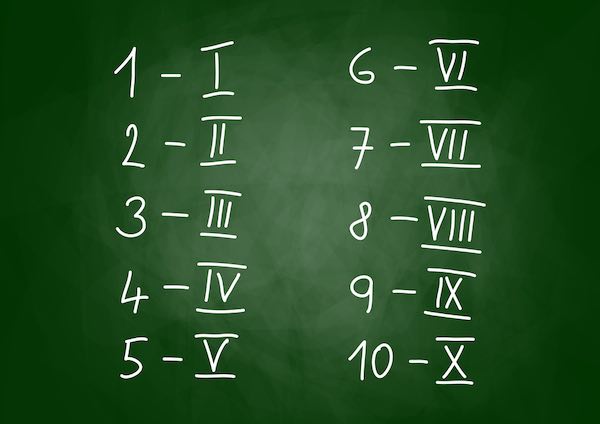All you need to know about Roman numerals and Roman numbers: names, symbols, use.
The Romans developed a system of numbers and numerals that we still use today.
At the core of the Roman numeral system, there is a basic set of latin letters, which the Romand combined to create any numeral they needed.
The latin letters the Romans used in their numeral system are: I, V, X, L, C, D, M
In this page, you find a Roman numeral chart, a list of Roman number names and the basic functioning of the ancient Roman counting system.
Before we dive into the world of Roman numbers, a coupled of definitions.
This article is part of our series ‘Learn about Ancient Rome‘

What is the difference between Roman numeral vs Roman number
A Romam Numeral is a symbol to indicate a certain number
A number is a mathematical tool to measure a quantity
Core ancient Roman numerals and their use
To Romans used a specific set of letters to identify what they used as core numeral:
- I = 1
- V = 5
- X = 10
- L =50
- C = 100
- D = 500
- M = 1000
Fun fact! Ancient Roman numbers did not include the number zero. Zero entered the system much later, as part of the Arabic numerical system we still use today.
Essential rules to write roman numerals
These basic symbols where combined to create new numerals with a system of addition / subtractions.

- When a big numeral precedes a smaller numeral, the numbers are added. So XI = X+I= 11
- When a smaller numeral a bigger numeral , the numbers are subtracted. So IX = 10 – 1= 9
- When a numeral is repeated 2 or 3 times, they get added. So XX = 10+10 = 20
- The same letter can only be used three time in a row. So VIII = 5 + 1+1+1 = 8 but 9 = IX
The easiest way to recognise Roman numbers is to identify the biggest numeral and work from it either adding or subtracting.
Roman numerals chart
| I | 1 |
| II | 2 |
| III | 3 |
| IV | 4 |
| V | 5 |
| VI | 6 |
| VII | 7 |
| VIII | 8 |
| IX | 9 |
| X | 10 |
| XI | 11 |
| XII | 12 |
| XIII | 13 |
| XVI | 14 |
| XV | 15 |
| XVI | 16 |
| XVII | 17 |
| XVIII | 18 |
| XIX | 19 |
| XX | 20 |
| XL | 40 |
| L | 50 |
| C | 10 |
| CC | 200 |
| D | 500 |
| M | 1000 |
These numerals were combined to create all types of numbers, ever very high ones.
For instance: 1983 as an ancient Roman number would read MCMLXXXIII
Roman numbers one to 100
| I | 1 |
| II | 2 |
| III | 3 |
| IV | 4 |
| V | 5 |
| VI | 6 |
| VII | 7 |
| VIII | 8 |
| IX | 9 |
| X | 10 |
| XI | 11 |
| XII | 12 |
| XIII | 13 |
| XIV | 14 |
| XV | 15 |
| XVI | 16 |
| XVII | 17 |
| XVIII | 18 |
| XIX | 19 |
| XX | 20 |
| XXI | 21 |
| XXII | 22 |
| XXIII | 23 |
| XXIV | 24 |
| XXV | 25 |
| XXVI | 26 |
| XXVII | 27 |
| XXVIII | 28 |
| XXIX | 29 |
| XXX | 30 |
| XXXI | 31 |
| XXXII | 32 |
| XXXIII | 33 |
| XXXIV | 34 |
| XXXV | 35 |
| XXXVI | 36 |
| XXXVII | 37 |
| XXXVIII | 38 |
| XXXIX | 39 |
| XL | 40 |
| XLI | 41 |
| XLII | 42 |
| XLIII | 43 |
| XLIV | 44 |
| XLV | 45 |
| XLVI | 46 |
| XLVII | 47 |
| XLVIII | 48 |
| XLIX | 49 |
| L | 50 |
| LI | 51 |
| LII | 52 |
| LIII | 53 |
| LIV | 54 |
| LV | 55 |
| LVI | 56 |
| LVII | 57 |
| LVIII | 58 |
| LIX | 59 |
| LX | 60 |
| LXI | 61 |
| LXII | 62 |
| LXIII | 63 |
| LXIV | 64 |
| LXV | 65 |
| LXVI | 66 |
| LXVII | 67 |
| LXVIII | 68 |
| LXIX | 69 |
| LXX | 70 |
| LXXI | 71 |
| LXXII | 72 |
| LXXIII | 73 |
| LXXIV | 74 |
| LXXV | 75 |
| LXXVI | 76 |
| LXXVII | 77 |
| LXXVIII | 78 |
| LXXIX | 79 |
| LXXX | 80 |
| LXXXI | 81 |
| LXXXII | 82 |
| LXXXIII | 83 |
| LXXXIV | 84 |
| LXXXV | 85 |
| LXXXVI | 86 |
| LXXXVII | 87 |
| LXXXVIII | 88 |
| LXXXIX | 89 |
| XC | 90 |
| XCI | 91 |
| XCII | 92 |
| XCIII | 92 |
| XCIV | 94 |
| XCV | 95 |
| XCVI | 96 |
| XCVII | 97 |
| XCVIII | 98 |
| XCIX | 99 |
| C | 100 |
The Latin names of Roman number
Roman numbers had names as follows:
| Roman numeral | Arabic Numeral | Roman Nummer name (masculine, feminine, neutral form) |
| I | 1 | unus, una, unum |
| II | 2 | duo, duae, duo |
| III | 3 | tres, tres, tria |
| IV | 4 | quattuor |
| V | 5 | quinque |
| VI | 6 | se x |
| VII | 7 | Septem |
| VIII | 8 | Octo |
| IX | 9 | Novem |
| X | 10 | diecem |
| XI | 11 | undecim |
| XII | 12 | duodecim |
| XIII | 13 | tredecim |
| XIV | 14 | quattuordecim |
| XV | 15 | quindecim |
| XVI | 16 | sedecim |
| XVII | 17 | septemdecim |
| XVIII | 18 | duodeviginti |
| XIX | 19 | undeviginti |
| XX | 20 | viginti |
| XXX | 30 | triginta |
| XL | 40 | quadraginta |
| L | 50 | quinquaginta |
| LX | 60 | sexaginta |
| LXX | 70 | septuaginta |
| LXXX | 80 | octoginta |
| XC | 90 | nonaginta |
| C | 100 | centum |
| CC | 200 | ducenti, ae, a |
| CCC | 300 | trecenti, ae, a |
| CD | 400 | quadringenti, ae, a |
| D | 500 | quingenti, ae, a |
| DC | 600 | sescenti, ae, a |
| DCC | 700 | septingenti, ae, a |
| DCCC | 800 | octingenti, ae, a |
| XM | 900 | nongenti, ae, a |
| M | 1000 | mille |
| MM | 2000 | duomilia |
| MMM | 3000 | triamdilia |
Chart of Ordinal Roman numbers first to tenth
| I | Primus |
| II | Secundus |
| III | Tertius |
| IV | Quartus |
| V | Quintus |
| VI | Sextus |
| VII | Septimus |
| VIII | Octavus |
| IX | Nonus |
| X | Decimus |
| XX | Vicesimus |
| L | Quinquagesimus |
| C | Centesimus |
| M | Millesimus |
Where do we see Roman numerals in use
Roman numerals are still widely used. You can commonly encounter them to mark chapters in a book, different tomes in a multi-volume book or to mark numbered aisles in places such as libraries and university halls.
They are also used on clock faces and any time a list wants to evoke a sense of refinement or elegance.
Roman numbers are also easy to see in Rome, where they regularly appear in ancient inscriptions and modern street names.
Examples: Via XX Settembre or, Rione XI
